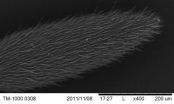(Press-News.org) This press release is available in French.
Have you ever wondered why some people find it so much easier to stop smoking than others? New research shows that vulnerability to smoking addiction is shaped by our genes. A study from the Montreal Neurological Institute and Hospital - The Neuro, McGill University shows that people with genetically fast nicotine metabolism have a significantly greater brain response to smoking cues than those with slow nicotine metabolism. Previous research shows that greater reactivity to smoking cues predicts decreased success at smoking cessation and that environmental cues promote increased nicotine intake in animals and humans. This new finding that nicotine metabolism rates affect the brain's response to smoking may lead the way for tailoring smoking cessation programs based on individual genetics.
Smoking cues, such as the sight of cigarettes or smokers, affect smoking behavior and are linked to relapse and cigarette use. Nicotine metabolism, by a liver enzyme, also influences smoking behavior. Variations in the gene that codes for this enzyme determine slow or fast rates of metabolism and therefore, the level of nicotine in the blood that reaches the brain. In the study smokers were screened for their nicotine metabolism rates and their enzyme genotype. Participants were aged 18 – 35 and smoked 5-25 cigarettes daily for a minimum of 2 years. People with the slowest and fastest metabolism had their brain response to visual smoking cues measured using functional MRI. Fast metabolizers had significantly greater response to visual cigarette cues than slow metabolizers in brain areas linked to memory, motivation and reward, namely the amygdala, hippocampus, striatum, insula, and cingulate cortex.
"The finding that nicotine metabolism rate has an impact on the brain's response to smoking cues supports our hypothesis that individuals with fast nicotine metabolism rates would have a greater brain response to smoking cues because of close coupling in everyday life between exposure to cigarettes and surges in blood nicotine concentration. In other words they learn to associate cigarette smoking with the nicotine surge," says clinician-scientist Dr. Alain Dagher, lead investigator at The Neuro. "In contrast, individuals with slow metabolism rates, who have relatively constant nicotine blood levels throughout the day, are less likely to develop conditioned responses to cues. For them, smoking is not associated with brief nicotine surges, so they are smoking for other reasons. Possibilities include maintenance of constant brain nicotine levels for cognitive enhancement (ie, improved attention, memory), or relief of stress or anxiety. "
Future research could focus on improving smoking cessation methods by tailoring treatments for different types of smokers. One possibility is to measure the rate of nicotine metabolism as part of the therapeutic decision-making process. For example, targeting cue-induced relapse risk may not help those with slow nicotine metabolism, who are more likely to benefit from long-acting cholinergic drugs such as the nicotine patch, consistent with previous clinical trials. Conversely the use of non-nicotine based therapies aimed at reducing craving may help fast metabolizers, as demonstrated for buproprion, an anti-depressant that has been used for smoking cessation.
###This research was supported by the Canadian Tobacco Control Research Initiative (AD), Fonds de Recherche en Santé du Québec (AD), and the Canadian Institutes of Health Research.
About The Neuro
The Montreal Neurological Institute and Hospital — the Neuro, is a unique academic medical centre dedicated to neuroscience. Founded in 1934 by the renowned Dr. Wilder Penfield, the Neuro is recognized internationally for integrating research, compassionate patient care and advanced training, all key to advances in science and medicine. The Neuro is a research and teaching institute of McGill University and forms the basis for the Neuroscience Mission of the McGill University Health Centre. Neuro researchers are world leaders in cellular and molecular neuroscience, brain imaging, cognitive neuroscience and the study and treatment of epilepsy, multiple sclerosis and neuromuscular disorders. For more information, visit theneuro.com.
How genetics shape our addictions
Genes predict the brain's reaction to smoking
2012-09-11
ELSE PRESS RELEASES FROM THIS DATE:
Gladstone scientists develop technique to decipher the dormant AIDS virus concealed in cells
2012-09-11
SAN FRANCISCO, CA—September 11, 2012—Scientists at the Gladstone Institutes have gotten us one step closer to understanding and overcoming one of the least-understood mechanisms of HIV infection—by devising a method to precisely track the life cycle of individual cells infected with HIV, the virus that causes AIDS.
In a paper being published online today in Lab on a Chip, the laboratory of Gladstone Investigator Leor Weinberger, PhD, announced the development of a device that can pinpoint and track HIV inside CD4 T cells—the type of white blood cell that the AIDS virus ...
Was Kepler's supernova unusually powerful?
2012-09-11
In 1604, a new star appeared in the night sky that was much brighter than Jupiter and dimmed over several weeks. This event was witnessed by sky watchers including the famous astronomer Johannes Kepler. Centuries later, the debris from this exploded star is known as the Kepler supernova remnant.
Astronomers have long studied the Kepler supernova remnant and tried to determine exactly what happened when the star exploded to create it. New analysis of a long observation from NASA's Chandra X-ray Observatory is providing more clues. This analysis suggests that the supernova ...
Survey shifts spotlight away from poor as key supporters of militants in Pakistan
2012-09-11
A groundbreaking survey of Pakistanis has found stronger support for militant groups among the middle class than the poor. The finding by a team including Princeton researchers challenges the conventional wisdom about links between economic status and views on militants that has helped shaped American foreign-aid policies since 2001.
The nationally representative survey of 6,000 Pakistani adults, conducted in the spring of 2009, also found that Pakistanis in general held militant groups in low regard. And, when the survey results were analyzed along with data that identified ...
High-altitude winds have large potential as a source of clean energy
2012-09-11
Airborne wind energy—an emerging approach to harnessing high-altitude winds—could scale up fairly quickly if given significant government support for research and development, according to a survey of experts by Near Zero, a nonprofit energy research organization.
Winds near Earth's surface are already used to generate substantial amounts of electricity. However, higher in the sky—much higher than today's wind turbines can reach—winds tend to be stronger and steadier, making these winds an even larger source of energy. According to recent research, the amount of energy ...
Salt seeds clouds in the Amazon rainforest
2012-09-11
It's morning, deep in the Amazon jungle. In the still air innumerable leaves glisten with moisture, and fog drifts through the trees. As the sun rises, clouds appear and float across the forest canopy ... but where do they come from? Water vapor needs solid surfaces to condense on. Airborne particles are the seeds of liquid droplets in fog, mist, and clouds.
To learn how aerosol particles form in the Amazon, Mary Gilles of the Chemical Sciences Division at the U.S. Department of Energy's Lawrence Berkeley National Laboratory (Berkeley Lab) and David Kilcoyne of the Lab's ...
UF researchers name new cusk-eels useful for understanding environment
2012-09-11
GAINESVILLE, Fla. -- A study by University of Florida and University of Kansas researchers describing eight new cusk-eel species provides data for better understanding how disasters like the 2010 Gulf of Mexico oil spill impact biodiversity and the environment.
The 60-year study appearing Tuesday in the Florida Museum of Natural History Bulletin provides a comprehensive taxonomic revision of one of the least-studied groups of cusk-eels, bony fishes distantly related to cod. Although abundant and widespread in the Americas, the fishes in the genus Lepophidium have previously ...
GEN reports on ocular therapeutics targeting the retina
2012-09-11
New Rochelle, NY, September 10, 2012-- Therapies for retinal diseases are expected to overtake those for glaucoma by 2014, reports Genetic Engineering & Biotechnology News (GEN). Because current retinal disease treatments only improve vision for six to eight weeks, there is a critical need for new remedies, according to a recent issue of GEN.
"As increasing numbers of baby-boomers continue to grow older, many will have to deal with eye diseases such as age-related macular degeneration," said John Sterling, Editor-in-Chief of GEN. "Some estimates put the current AMD and ...
Pain drug can kill resistant tuberculosis
2012-09-11
NEW YORK (September 10, 2012) -- An off-patent anti-inflammatory drug that costs around two cents for a daily dose in developing countries has been found by researchers at Weill Cornell Medical College to kill both replicating and non-replicating drug resistant tuberculosis in the laboratory -- a feat few currently approved TB drugs can do, and resistance to those is spreading.
Their findings, published online by the journal PNAS, point to a potential new therapy for the more than 500,000 people worldwide whose TB has become resistant to standard drug treatments. But ...
Rhode Island Hospital study shows wine has more cardiovascular benefits than vodka
2012-09-11
PROVIDENCE, R.I. – The next time you call someone a drunken pig, remember this study. Rhode Island Hospital researcher Frank Sellke, M.D., chief of cardiothoracic surgery at Rhode Island and The Miriam hospitals, and his colleagues studied the effects of red wine and vodka on pigs with high cholesterol and found that the pigs with a penchant for pinot noir fared better than their vodka swilling swine counterparts. The paper is published in the September issue of the journal Circulation.
"There has been previous research touting the benefits of moderate consumption of ...
Ants have an exceptionally 'hi-def' sense of smell
2012-09-11
Ants have four to five times more odor receptors than most other insects, a team of researchers have discovered.
The research team, led by Lawrence Zwiebel at Vanderbilt, recently completed the first full map of olfactory system that provides ants with their sense of taste and smell. They found the industrious insects have genes that make about 400 distinct odorant receptors, special proteins that detect different odors. By comparison, silk moths have 52, fruit flies have 61, mosquitoes range from 74 to 158 and honeybees have 174.
"The most exciting moment for me was ...
LAST 30 PRESS RELEASES:
University of Phoenix College of Doctoral Studies releases white paper on AI-driven skilling to reduce burnout and restore worker autonomy
AIs fail at the game of visual “telephone”
The levers for a sustainable food system
Potential changes in US homelessness by ending federal support for housing first programs
Vulnerability of large language models to prompt injection when providing medical advice
Researchers develop new system for high-energy-density, long-life, multi-electron transfer bromine-based flow batteries
Ending federal support for housing first programs could increase U.S. homelessness by 5% in one year, new JAMA study finds
New research uncovers molecular ‘safety switch’ shielding cancers from immune attack
Bacteria resisting viral infection can still sink carbon to ocean floor
Younger biological age may increase depression risk in older women during COVID-19
Bharat Innovates 2026 National Basecamp Showcases India’s Most Promising Deep-Tech Ventures
Here’s what determines whether your income level rises or falls
SCIE indexation achievement: Celebrate with Space: Science & Technology
Children’s Hospital Colorado performs region’s first pediatric heart and liver dual organ transplant
Australian team discover why quantum computers have memory problems over time
What determines the fate of a T cell?
Candida auris: genetic process revealed which could be treatment target for deadly fungal disease
Groundbreaking discovery turns household plastic recycling into anti-cancer medication
Blocking a key inflammatory pathway improves liver structure and vascular function in cirrhosis, study finds
Continuous spread: Raccoon roundworm detected in nine European countries
HKUST Engineering researchers developed a novel photodetector to enhance the performance of on-chip light monitoring
Strategic river sensors could have forewarned of Texas Camp flood disaster
Drone sampling of whale breath reveals first evidence of potentially deadly virus in Arctic
Roman soldiers defending Hadrian’s Wall infected by parasites, study finds
Pinochet’s prisoners were tormented with music but still found solace in it, a new book reveals
Fertility remains high in rural Tanzania despite access to family planning
AI-assisted device can improve autism care access
Kinetic careers
Uncovering how parasitic plants avoid attacking themselves to improve crop resistance
Nanoparticle vaccine strategy could protect against Ebola and other deadly filoviruses
[Press-News.org] How genetics shape our addictionsGenes predict the brain's reaction to smoking





